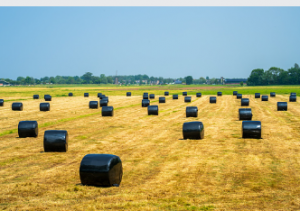How to Choose the Right Material for Bale Wrap
Several options exist for bale wrap, from sisal twine to Plastic film and net wrap. These bale wraps are made to withstand the rigours of bale wrapping. However, you should use suitable materials for the right job. In this article, we’ll go over the various options available.
 Net wrap
Net wrap
Net wrap for bale wrap is made by knitting weft and warp threads in waves, which helps the wrap spread evenly across the bale. It is then fed onto the bale in a round baling machine chamber. This method effectively ensures the wrap is evenly spread across the entire circumference of the bale.
Most major baler manufacturers produce several varieties of net wrap. For example, the Syfilco Bale Net Wrap is manufactured in Canada, while Gardien the Protector(TM) is available exclusively in Canada. Net wraps made by leading manufacturers are available in various sizes, from 48 to 67 inches wide.
Plastic film
There are several advantages to using plastic film to wrap bales when storing hay. First, these films are durable, and they can be reused. Furthermore, they are free from harsh chemicals, so there is less risk of damaging the bales. These films also help maintain the freshness of the bales. Finally, it makes them ready to be fed to animals.
Plastic film is an environmentally-friendly material that helps prevent harvest loss. The film will protect the hay from bleaching caused by the sun and prevent moisture from penetrating the bales. Its moisture-reduction properties make it an excellent choice for bale wrap, as it prevents hay from falling out of the baler. It also prevents forage spoilage since hay that has fallen out of the baler will be unable to metabolize the nutrients.
Silage stretch film
Silage stretch film for bale wrap is one of the most critical components for protecting baled forage. This multilayer film has good adhesive properties and a perfect seal around the bale. It can be used on square and round bales. Its optimum strength and tear resistance ensure maximum feed quality.
Silage stretch film for bale wrap must have high cling properties on the exterior surface of the roll. It should have a cling strength of five to ten N/m. It must also contain UV masterbatch to protect against sun damage. This process is quick and straightforward.
Visqueen Polycrop is an excellent choice for bale wrap. It is manufactured using specially selected raw materials to ensure consistent quality and performance. Its constant electronic monitoring ensures that film thickness is uniform throughout the wrapping process. It is available in five layers and can be applied to round and square bales. It is suitable for most modern wrappers, including high-speed wrapping machines. Its uniform application on bales enhances the efficiency of wrapping operations.
BioNet
A PhD student from Imperial College London has devised a new way to wrap hay bales with edible plastic. The biopolymer, called BioNet, can be ingested by a human and is easily digestible. The invention was presented at Imperial’s Venture Catalyst Challenge, an enterprise pre-accelerator. The team hopes to commercialize their product within three to five years. They are currently working on adding probiotics and other beneficial elements to the wrap.
The biopolymer is easily compostable and can be laced with probiotics and nutrients for livestock. It can also reduce the amount of waste in livestock feed. BioNet bale wrap can be used on farms all over the world.
Using bale wrap to store hay is an excellent way to reduce dry matter loss. However, this method is not without its disadvantages. Let’s look at some of them. The first is that the film wrapped in a bale is often not as durable as we’d like.
Biodegradable material can protect bales from sunlight, moisture, and other elements. The St. Thomas Aquinas School team is developing an edible wrap that can be used in existing machinery. However, there are some concerns about the safety of using wrap-around livestock. Although the students haven’t been able to test their wrap in the field yet, they are optimistic about their prospects.
A bale wrap will protect a bale from birds, rodents, and other contaminants. It will also reduce the amount of waste that goes into a bale. In addition, a good bale wrap should also preserve its nutritional value. Moreover, a good bale wrap should have good tear resistance.


